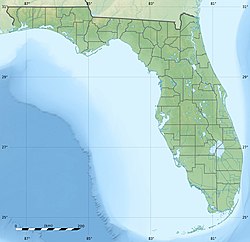Pensacola | |
|---|---|
 Clockwise from top: Pensacola skyline, Pensacola Museum of History, University of West Florida Library, Escambia County Courthouse, William Dudley Chipley Obelisk, National Naval Aviation Museum | |
| Motto: "Florida's First & Future" | |
 Location in Escambia County and the state of Florida | |
| Coordinates: 30°25′17″N 87°13′02″W / 30.42139°N 87.21722°W | |
| Country | United States |
| State | Florida |
| County | Escambia |
| First settled | 1559 |
| Resettled | 1667 |
| Incorporated | 1822[1] |
| Founded by | Don Tristan de Luna |
| Government | |
| • Type | Mayor–Council |
| • Body | Pensacola City Council |
| • Mayor | D. C. Reeves (R) |
| • Council President | Casey Jones |
| • Council Members | Delarian Wiggins, Jennifer Brahier, Allison Patton, Teniadé Broughton, Charles Bare, and Council Vice President Jared Moore |
| • City Administrator | Kerrith Fiddler |
| • City Clerk | Ericka Burnett |
| Area | |
• City | 41.12 sq mi (106.49 km2) |
| • Land | 22.76 sq mi (58.95 km2) |
| • Water | 18.36 sq mi (47.54 km2) |
| • Metro | 1,669.30 sq mi (4,323.5 km2) |
| Elevation | 102 ft (31 m) |
| Population (2020) | |
• City | 54,312 |
| • Density | 2,386.19/sq mi (921.30/km2) |
| • Urban | 390,172 (US: 108th) |
| • Urban density | 1,486.2/sq mi (573.8/km2) |
| • Metro | 509,905 (US: 110th) |
| • Metro density | 1,669.30/sq mi (644.52/km2) |
| Demonym | Pensacolian |
| Time zone | UTC−6 (CST) |
| • Summer (DST) | UTC−5 (CDT) |
| ZIP codes | 32501-32509, 32511-32514, 32516, 32520-32524, 32526, 32534, 32559, 32573-32576, 32581, 32582, 32589-32598 |
| Area code(s) | 850, 448 |
| FIPS code | 12-55925[3] |
| GNIS feature ID | 0294117[4] |
| Website | www |
Pensacola (/ˌpɛnsəˈkoʊlə/ PEN-sə-KOH-lə) is a city in the Florida Panhandle in the United States. It is the county seat and only city in Escambia County. It is the principal city of the Pensacola Metropolitan Statistical Area, which had 511,503 residents in 2020.[5]
Pensacola was first settled by the Spanish Empire in 1559, predating the establishment of St. Augustine by six years,[6] and was abandoned due to a significant hurricane and not re-established until 1698.[7] Pensacola is a seaport on Pensacola Bay, which is protected by the barrier island of Santa Rosa and connects to the Gulf of Mexico. A large United States Naval Air Station, the first in the United States, is located in Pensacola. It is the base of the Blue Angels flight demonstration team and the National Naval Aviation Museum. The University of West Florida is situated north of the city center.
The area was originally inhabited by Muskogean-speaking peoples.[citation needed] The Pensacola people lived there at the time of European contact, and Creek people frequently visited and traded from present-day southern Alabama and Mississippi and southeast of Louisiana. Spanish explorer Tristán de Luna founded a short-lived settlement in 1559.[8] In 1698 the Spanish established a presidio in the area, from which the modern city gradually developed. The area changed hands several times as European powers competed in North America. During Florida's British rule (1763–1781), fortifications were strengthened.[citation needed]
It is nicknamed "The City of Five Flags", due to the five governments that have ruled it during its history: the flags of Spain (Castile), France, Great Britain, the United States of America, and the Confederate States of America. Other nicknames include "World's Whitest Beaches" (due to the white sand of Florida panhandle beaches), "Cradle of Naval Aviation", "Western Gate to the Sunshine State", "America's First Settlement", "Emerald Coast", "Redneck Riviera", and "P-Cola".
- ^ "FLORIDA CITIES BY INCORPORATION YEAR WITH INCORPORATION & DISSOLUTION INFO" (PDF). www.flcities.com.
- ^ "2020 U.S. Gazetteer Files". United States Census Bureau. Archived from the original on March 18, 2021. Retrieved October 31, 2021.
- ^ "U.S. Census website". United States Census Bureau. Archived from the original on December 27, 1996. Retrieved January 31, 2008.
- ^ "US Board on Geographic Names". United States Geological Survey. October 25, 2007. Archived from the original on February 4, 2012. Retrieved January 31, 2008.
- ^ "Pensacola, Florida", Wikipedia, August 30, 2024, retrieved August 31, 2024
- ^ "Tristan de Luna y Arellano | University of West Florida". uwf.edu. Retrieved August 31, 2024.
- ^ "Emanuel Point Shipwreck". Visit Pensacola. Retrieved October 9, 2024.
- ^ Worth, John E. "The Tristán de Luna Expedition, 1559-1561". uwf.edu. Archived from the original on June 30, 2016.



